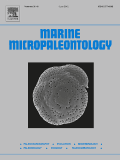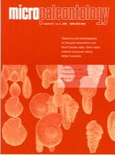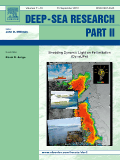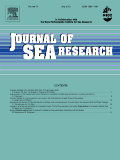
MARINE MICROPALEONTOLOGY
Scope & Guideline
Exploring the Depths of Marine History
Introduction
Aims and Scopes
- Microscopic Marine Organisms Studies:
The journal emphasizes the investigation of various microscopic marine organisms, including foraminifera, diatoms, coccolithophores, and dinoflagellates, providing essential data for paleoecological reconstructions. - Paleoenvironmental Reconstructions:
Research published in this journal often focuses on reconstructing ancient marine environments using micropaleontological data, which aids in understanding historical climate changes and marine biodiversity. - Biostratigraphy and Paleoecology:
The journal covers studies that utilize micropaleontological techniques for biostratigraphic analysis, helping to establish chronological frameworks and understand the ecological dynamics of past marine communities. - Geochemical and Isotopic Analyses:
Many articles incorporate geochemical and stable isotopic approaches to interpret the environmental conditions of ancient marine ecosystems, enhancing the understanding of biogeochemical cycles. - Technological Innovations in Micropaleontology:
The journal promotes methodological advancements, including imaging techniques and molecular analyses, to improve the extraction, identification, and understanding of micropaleontological specimens.
Trending and Emerging
- Ecological and Environmental Signals:
A notable trend is the focus on understanding ecological signals and responses of marine organisms to environmental changes, particularly in the context of climate change and human impacts on marine ecosystems. - Use of Advanced Imaging and Analytical Techniques:
Recent studies increasingly utilize advanced imaging techniques and molecular methods, such as 3D imaging and metabarcoding, to explore foraminiferal microhabitats and community dynamics. - Interdisciplinary Approaches:
There is a growing emphasis on interdisciplinary research that combines micropaleontology with geology, oceanography, and climate science to provide comprehensive insights into past marine environments. - Impact of Anthropogenic Factors:
Research increasingly addresses the impacts of anthropogenic activities on marine ecosystems, examining how human-induced changes affect micropaleontological records and marine biodiversity. - Focus on Historical Climate Events:
Emerging studies highlight historical climate events, such as the Paleocene-Eocene Thermal Maximum and the Late Miocene-Early Pliocene Biogenic Bloom, to understand the long-term impacts of climate change on marine life.
Declining or Waning
- Traditional Biostratigraphy Alone:
While biostratigraphy remains important, there has been a noticeable decline in studies that rely solely on traditional biostratigraphic methods without integrating geochemical or ecological perspectives. - Focus on Single Taxa:
Research that primarily concentrates on single taxa, without considering broader ecological or environmental contexts, has become less common as the field moves towards more integrative approaches. - Descriptive Studies:
There is a waning interest in purely descriptive studies of new species or assemblages, as the field increasingly values studies that address ecological implications and broader environmental changes.
Similar Journals

GEO-MARINE LETTERS
Navigating the Frontiers of Environmental ScienceGEO-MARINE LETTERS, published by Springer, is a prestigious academic journal that has been a pivotal platform for the dissemination of innovative research in the fields of Earth and Planetary Sciences, Oceanography, Environmental Science, and Geotechnical Engineering since its inception in 1981. With an E-ISSN of 1432-1157, this journal has established itself in the Q2 quartile across multiple categories in 2023, indicating its influential position within the scientific community, as reflected by its Scopus rankings. While it currently does not offer an open access option, its rigorous peer-review process ensures the publication of high-quality research that contributes significantly to advancing our understanding of marine and geological sciences. Researchers, professionals, and students alike will benefit from the diverse scope of studies featured in GEO-MARINE LETTERS, making it an essential resource for those engaged in environmental and marine research. Situated in Germany, the journal's commitment to excellence continues to shape critical discussions and innovations in the field.

Annual Review of Marine Science
Connecting researchers to the pulse of marine exploration.The Annual Review of Marine Science is a leading academic journal published by Annual Reviews, dedicated to advancing the field of marine science through comprehensive and insightful reviews. With an ISSN of 1941-1405 and E-ISSN 1941-0611, this esteemed journal has established itself as a critical resource for researchers, professionals, and students alike. Recognized for its exceptional quality, it holds a prestigious Q1 ranking in Oceanography for 2023, ranking first out of 145 journals in the Earth and Planetary Sciences category, placing it within the top 1% of its field. The Annual Review of Marine Science covers an expansive scope, incorporating cutting-edge research that spans the biological, chemical, and physical realms of marine studies. It fosters an environment of knowledge sharing and academic discourse, thereby augmenting the understanding of marine ecosystems and their global significance. While the journal is not open access, it ensures that the latest advancements and reviews are made available to a broad audience, reflecting the importance of marine science in addressing pressing environmental challenges. With its dedicated editorial team and commitment to scholarly rigor, the journal is an indispensable platform for advancing marine research and education from its base in the United States.

Ocean Science Journal
Innovating Solutions for Oceanic ChallengesOcean Science Journal, published by the Korea Institute of Ocean Science and Technology (KIOST), is a pivotal resource for scholars and practitioners in the field of oceanography. With the ISSN 1738-5261 and E-ISSN 2005-7172, this journal presents cutting-edge research from 2006 to 2024, bridging fundamental and applied ocean sciences. Based in South Korea, with its headquarters located in Busan, the journal has achieved a commendable Scopus rank of #72 out of 145 in the domain of Earth and Planetary Sciences, placing it in the 50th percentile among peer publications. Classified in the Q3 category of the 2023 Oceanography rankings, Ocean Science Journal offers a platform for innovative studies that advance understanding of marine environments and promote sustainable ocean practices. While it does not operate under an open access model, readers and contributors can expect high-quality, peer-reviewed material that addresses pressing oceanic challenges and developments. This journal serves as an essential tool for researchers, professionals, and students committed to fostering marine science and ocean technology.

MICROPALEONTOLOGY
Connecting Ancient Worlds to Modern ScienceMICROPALEONTOLOGY is a prominent journal dedicated to advancing the field of paleontology, published by MICRO PRESS. With an ISSN of 0026-2803 and an E-ISSN of 1937-2795, this esteemed publication has been a vital resource since its inception in 1979, continuing to influence the field through 2024. The journal ranks within the Q2 category for Paleontology, highlighting its relevance and quality in the academic community. Notably, it holds a Scopus rank of #41 out of 113 within the Earth and Planetary Sciences field, placing it in the 64th percentile, indicative of its significant impact. Although not an open-access journal, MICROPALEONTOLOGY remains committed to disseminating crucial research findings, making it an essential platform for researchers, professionals, and students dedicated to exploring the intricacies of microfossils and their implications for understanding past environments. With its strategic focus and rigorous peer-review process, this journal plays a critical role in bridging past geological events with contemporary scientific inquiries.

DEEP-SEA RESEARCH PART II-TOPICAL STUDIES IN OCEANOGRAPHY
Advancing Insights in Deep-Sea ResearchDEEP-SEA RESEARCH PART II-TOPICAL STUDIES IN OCEANOGRAPHY is a leading journal in the field of oceanography, published by PERGAMON-ELSEVIER SCIENCE LTD. With an impressive ranking of Q1 in Oceanography and holding the 20th position out of 145 journals in the Earth and Planetary Sciences category, this journal provides a prominent platform for researchers and practitioners alike. Covering topical studies in oceanography since its inception in 1993, it continues to contribute significant insights into deep-sea research, enhancing our understanding of marine environments. Although the journal does not presently offer Open Access options, it remains a vital resource, appealing to students and professionals who seek to engage with innovative research and practical applications in the oceanographic community. The journal's ongoing commitment to excellence is evident as it plays a crucial role in advancing the field leading up to the present day and beyond.

PROGRESS IN OCEANOGRAPHY
Innovating Ocean Research for a Sustainable FuturePROGRESS IN OCEANOGRAPHY is a pivotal journal published by PERGAMON-ELSEVIER SCIENCE LTD, dedicated to advancing the field of oceanographic research and exploration. With an ISSN of 0079-6611 and an E-ISSN of 1873-4472, this esteemed publication has been disseminating significant findings from 1963 and continues to be a cornerstone in aquatic sciences and geology, holding a distinguished Q1 ranking in both categories as of 2023. The journal primarily focuses on innovative research that contributes to our understanding of ocean processes, marine ecosystems, and the impact of human activities on the oceans. Its exclusive access model facilitates the dissemination of high-quality content that resonates with researchers, professionals, and students alike, ensuring that vital insights are accessible to the global scientific community. With a firm commitment to upholding rigorous scientific standards, PROGRESS IN OCEANOGRAPHY remains an influential platform for the communication of groundbreaking research, providing scholars with invaluable resources to drive future oceanographic studies.

Indian Journal of Geo-Marine Sciences
Innovating Insights into Marine Ecosystems and GeologyThe Indian Journal of Geo-Marine Sciences, published by the NATIONAL INSTITUTE OF SCIENCE COMMUNICATION & INFORMATICS (NISCAIR), serves as a vital platform dedicated to the dissemination and advancement of knowledge in the field of marine and geosciences. As an open-access journal, it allows for improved visibility and accessibility of research findings to a global audience, enabling researchers, professionals, and students to share insights into oceanography and related disciplines. With a publication history spanning from 2007 to 2010 and continuing from 2012 to 2024, it has established itself within the academic community as a reliable source of innovative research, despite being classified in Q4 of Oceanography and holding a Scopus rank that places it in the 27th percentile. This journal is particularly relevant for those investigating marine ecosystems, geological oceanography, and their interconnections, thus playing an essential role in fostering understanding and communication within this important area of scientific inquiry.

OCEANOLOGY
Illuminating the Mysteries of the OceanOCEANOLOGY is a distinguished journal published by Pleiades Publishing Inc that has been a pivotal platform for advancing knowledge in the field of oceanography since its inception. With an ISSN of 0001-4370 and E-ISSN 1531-8508, this journal covers a range of topics related to marine sciences, geographical oceanography, and environmental studies, providing insights and research that significantly contribute to our understanding of oceanic systems. Recognized for its academic rigor, OCEANOLOGY holds a Q3 quartile ranking in the Oceanography category as of 2023, reflecting its impact within the scientific community as evidenced by its Scopus rank of 85 out of 145. Although currently not an open-access journal, OCEANOLOGY remains essential for researchers, professionals, and students by offering a comprehensive collection of peer-reviewed articles. This multidisciplinary approach equips its audience with valuable data and perspectives critical for ongoing research and development in ocean-related fields.

Marine Biodiversity
Elevating Understanding of Oceanic DynamicsMarine Biodiversity, published by SPRINGER HEIDELBERG, stands as a pivotal journal in the fields of Aquatic Science, Ecology, Evolution, Behavior and Systematics, and Oceanography. Established in 2009, it has gained a prominent place in academic discourse, evidenced by its Q2 ranking across multiple categories in the latest 2023 assessments. The journal operates out of Germany, specifically from its Heidelberg address, and caters to an international audience with a keen interest in the vast and complex dynamics of marine ecosystems. With an ongoing convergence of research outputs until 2024, Marine Biodiversity encourages contributions that expand our comprehension of marine life and its conservation, positioning itself as a vital resource for researchers, professionals, and students alike. Although currently not an open access journal, it maintains a robust reputation backed by its favorable Scopus ranks, which indicate its significant contribution to the respective fields. By disseminating high-quality, peer-reviewed articles, Marine Biodiversity plays an essential role in promoting scholarly communication and advancement in marine science.

JOURNAL OF SEA RESEARCH
Fostering Interdisciplinary Insights in Marine ResearchJOURNAL OF SEA RESEARCH, published by Elsevier, is a premier academic journal dedicated to advancing knowledge in the fields of aquatic science, ecology, and oceanography. Since its inception in 1996, this journal has provided a vital platform for researchers and professionals to disseminate groundbreaking findings and promote fostering interdisciplinary discussions. With its impressive Q2 ranking in multiple categories, including Aquatic Science and Ecology, Evolution, Behavior and Systematics, it positions itself as a significant contributor to marine and environmental studies. The journal is accessible in both print (ISSN: 1385-1101) and online formats (E-ISSN: 1873-1414), ensuring wide reach and engagement within the scholarly community. Researchers and students alike will find the journal not only a reliable source of information but also a source of inspiration for future explorations. With a commitment to quality and a broad scope that spans fundamental to applied research, JOURNAL OF SEA RESEARCH remains an indispensable resource for understanding the complexities of marine environments and their relevance to our changing world.